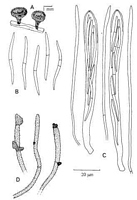|
 Lachnum melanophthalmum Lachnum melanophthalmum
SynonymsDasyscyphus melanophthalmus
BiostatusPresent in region - Indigenous. Endemic
Images (click to enlarge)
Caption: Fig. 9. Dasyscyphus melanophthahnus. Habit sketch x 10, details x 660. | 
Caption: Figure 109. Lachnum melanophthalmum, holotype. A. Apothecia. B. Ascospores. C. Asci
and paraphyses. D. Hairs. |
Article: Spooner, B.M. (1987). Helotiales of Australasia: Geoglossaceae, Orbiliaceae, Sclerotiniaceae, Hyaloscyphaceae. Bibliotheca Mycologica 116: 711 p.
Description: APOTHECIA superficial, stipitate, scattered or in small clusters. DISC 0.5-2.0 mm diam.,
dark reddish-brown, drying black, concave, smooth. RECEPTACLE cupulate, concolorous,
densely clothed with whitish hairs which frequently bear irregular masses of deep amber or
rust-coloured resinous exudate. STIPE central, tapered, slightly shorter than disc diam.,
usually darkened at the base, similarly clothed with hairs. HAIRS mostly 30-60 x 2.5-4.0 µm,
cylindric, obtuse, septate, thin-walled, granulate throughout, frequently encrusted with
reddish-brown resinous exudate and often cohering in groups. ASCI 115-123 x 7-8 µm, 8-spored, narrowly cylindric-clavate, apex conical, pore blue in Melzer's reagent.
ASCOSPORES 29-43 x 1.8-2.5, mean 36.7(SD 3.1) x mean 2.0(SD 0..2) µm, hyaline,
narrowly fusoidal, usually curved or sinuous, becoming 1-septate, irregularly arranged in 2 or
3 series within the ascus. PARAPHYSES narrowly lanceolate, narrowed but not acutely
pointed at the apex, remotely septate, 2.0-2.5 µm diam., not or slightly exceeding the asci.
SUBHYMENIUM up to 55 µm thick at centre, hyaline, composed of closely woven hyphae
2.5-4-5 µm diam. MEDULLARY EXCIPULUM hyaline, composed in the stipe of compact,
vertically arranged hyphae 3-4 µm diam., radiating into the receptacle to form a layer 20-30
µm thick adjacent to the ectal tissue; in the centre of the receptacle composed of loosely
interwoven hyphae 2.0-4.5 µm diam. ECTAL EXCIPULUM a thin layer up to 30 µm thick at
the base of the receptacle, composed of hyaline, thin-walled prismatic cells mostly 12-20 x 4-7
µm, lying at a very low angle to the surface
Habitat: On dead wood and bark of Nothofagus sp.
Distribution: Known only from the type locality.
Notes: This species is evidently known, as yet, only from the holotype collection, no other material
having come to attention during the present study. However, this collection is in good
condition and all apothecia are quite constant in appearance. None of the closely related
species discussed below has any apothecia with such colours, and L. melanophthalmum would
appear to be a good, distinctive species most readily recognized by the colour of the disc,
which is black when dry. The hairs are rather short and whitish, but bear variable quantities of
a deep amber-coloured resinous exudate so that apothecia frequently appear to be clothed
with brown hairs. The spores are evidently slightly longer than in the most closely related
taxa, though further collections would be desirable to confirm this observation. There is no
doubt that the species is congeneric with the type of Lachnum, and the appropriate
combination is, therefore, proposed.
Haines & Dumont (1984) have published a revision of the long-spored lignicolous species of
Lachnum. These are mostly tropical in distribution, but the intergradation of spore length
with mostly shorter-spored temperate species seems to preclude the possibility of recognizing
them as a distinct taxonomic unit. Encrustation of the hairs with coloured, resinous exudate is
characteristic of many of these species, some of which are similar and surely closely related to
L. melanophthalmum. However, most differ in having longer spores and none of the known
species has such a deeply pigmented disc. Lachnum acterotii (A. L. Smith) Haines & Dumont
is close to the present species, but differs, apart from disc colour, in having slightly shorter
spores which are regularly 3-septate. Lachnum brasitiense (Mont.) Haines & Dumont is also
very close, having comparable, often 1-septate spores, but has a pale disc and pure white hairs
which completely lack resinous exudate.
Two further species, L. lachnoderma and L. nothofagi. recorded as yet only from the
Australasian region, are probably also closely related to L. melanophthalmum. The
relationships and status of these species are discussed below. The former is, perhaps, closer to
L. sclerotii in having 3-septate spores, but L. nothofagi appears to differ from L.
melanophthalmum only in having a paler disc and shorter spores.
Article: Dennis, R.W.G. (1961). Some inoperculate Discomycetes from New Zealand. Kew Bulletin 15(2): 293-320.
Notes: Durieu's figure of Peziza phaeotricha (in Expl. Sci. Algerie, Bot. tab. 28, fig. 5A) gives a
good idea of the macroscopic appearance of D. melanophthalmus but Durieu's fungus was on
leaves of Quercus ilex. The hairs of Dingley 18981 bear a reddish-brown gummy secretion at
their tips and the colour of the receptacle varies from light brown to deep red-brown
according to the quantity of this exudate. The excipulum is composed of thin-walled, hyaline,
prismatic cells and the disc, black when dry, appears reddish-brown when soaked up. D.
javanicus Penz. & Sacc. differs in its fusiform ascospores 16-22 x 2-2.5 µ.
|